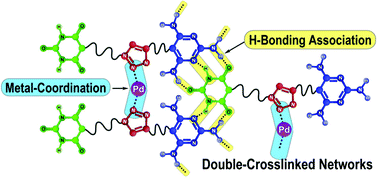Construction and morphology of non-covalently double-crosslinked supramolecular polymer networks†
Abstract
Hydrogen-bonding (H-bonding) association and metal-coordination constitute the highly relevant structural moieties of (macro)molecular self-assemblies, and they bridge synthetic and biological sciences, implementing dynamic features into (macro)molecules and materials which are not available through covalent bonds. Here, we present a straightforward synthesis of α-Ba, ω-TAP functionalized polymers, Ba-PnBuA-TAP (Ba: barbiturate, PnBuA: poly(n-butyl acrylate), TAP: 2,4,6-triaminopyrimidine), via the combination of an activator generated by the electron transfer atom transfer radical polymerization (AGET ATRP) process and copper-catalyzed azide–alkyne cycloaddition (CuAAC) click reaction. This strategy endows the inclusion of H-bonding moieties (Ba/TAP), and 1,2,3-triazole acting as a bridging ligand for metal-coordination with palladium(II). Both H-bonding association and metal-coordination play complementary yet pairwise orthogonal roles in the network formation from Ba-PnBuA-TAP, acting as the driving force for the polymer stepwise self-assembly. As a result, non-covalently double-crosslinked PnBuA networks are formed, leading to assemblies with remarkably improved mechanical properties: from liquid-like to solid-like materials, and then to a free-standing film. As a consequence, dramatic morphological conversion from a homogeneous film to disc-like nano-objects, and then to larger, more crowded aggregates, has also been observed. These findings may offer new opportunities to construct both higher ordered synthetic structures and smart materials accompanied by various levels of responsiveness.



 Please wait while we load your content...
Please wait while we load your content...